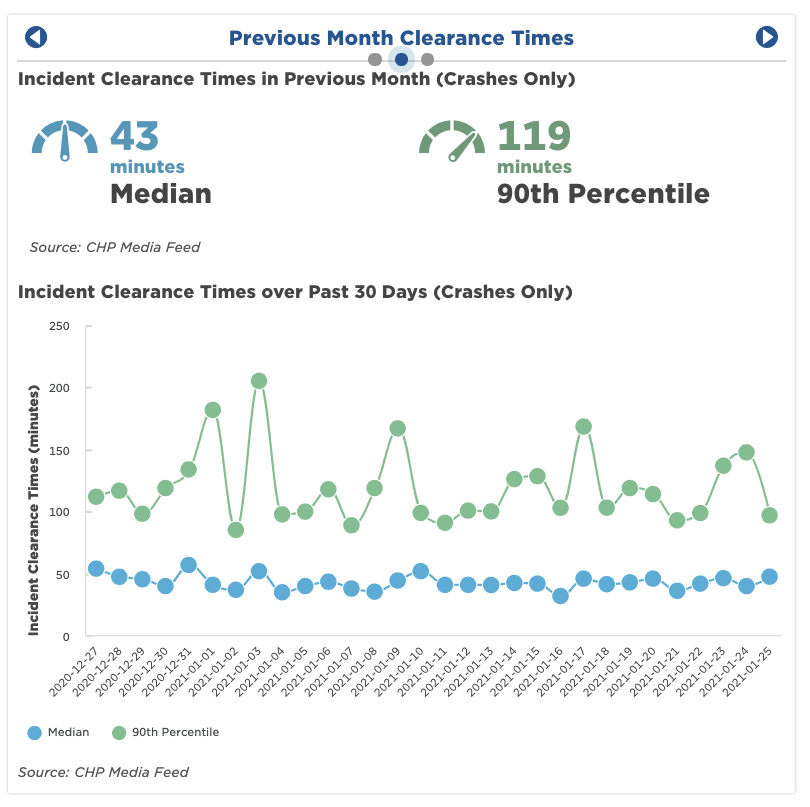February 18, 2021
Innovation of the Month:
NextGen TIM
Next-Generation Traffic Incident Management (NextGen TIM) focuses on working with State, local, and Tribal partners to improve TIM on all roadways. These entities are poised to take TIM to the next level by using innovative approaches that will continue to improve safety and travel reliability, saving lives, time, and money. Part three of our four-week series on NextGen TIM focuses on TIM data.
The collection, analysis, and use of TIM data are changing the way that law enforcement, fire, emergency medical services, transportation, and towing agencies perform their respective jobs. The most advanced TIM data programs are leveraging analysis towards organizational objectives like improving responder safety, improving travel time reliability, and helping commerce. As a first step, agencies are encouraged to adopt four key TIM performance measures: roadway clearance time, incident clearance time, the number of secondary crashes, and the number of responders struck.
TIM data to support these performance measures can come from public safety computer-aided dispatch system time stamps, law enforcement traffic crash reports, safety service patrol applications, and transportation management centers. Crowdsourced data, which originates from roadway users, is a relatively new data source that can bolster TIM data, particularly with respect to the detection of incidents and identification of when roadways return to normal after clearance.
Once data collection is established, agencies can understand the impacts of incidents and how responder actions can affect incident duration. For example, comparing roadway and incident clearance times with historical averages enables response agencies to better allocate resources and refine procedures related to crash investigation and towing. Printed reports and web-based dashboard tools are helping agencies share their TIM data and analysis.
Metropolitan Transportation Commission’s Bay Area Traffic Incident Management Dashboard uses incident details recorded from California Highway Patrol’s public facing incident-feed and California Department of Transportation’s Performance Management System (PeMS). The dashboard shows a summary of recent incidents as well as longer-term incident trends over the past 5 years. The dashboard includes incident clearance times and goals based on incident type. Data can easily be visualized through a toggle option on the website or the raw data can be downloaded.

The MTC has used the dashboard to understand incident clearance times and trends during travel restricted periods and regularly reviews it with responders to provide context for discussions at task force meetings. For example, recent meetings have focused on wrong way incidents and truck incidents and the dashboard has provided context on where wrong way incidents are happening, and how long truck incidents typically take to clear.
The MTC plans to use the dashboard in the future to help evaluate recently installed safety improvements, such as mile marker signs to aid with locating incidents in complex freeway interchanges and a suite of safety improvements to reduce crashes in a high collision mountain corridor.
To learn more NextGen TIM training opportunities, contact Paul Jodoin or James Austrich, EDC-6 team co-leads, or visit the team’s EDC website.
Rumble Strips: The Sweet Sound of Safety
Rumble strips are proven to reduce severe roadway departure crashes. However, some communities do not like the sound they make near residential areas. To change this mindset, FHWA created a video to reframe the discussion.
Instead of thinking of the "rumble strip sound" as annoying, the video encourages people to think of it like other sounds that warn of us danger – fire alarms and snake rattles.
People do not complain about those sounds because they are associated with safety. Rumble Strips: The Sweet Sound of Safety frames the sound of rumble strips the same way. Celebrate the sound of rumble strips when you hear it, because someone’s life could have just been saved!
To learn more about rumble strips or how to reduce rural roadway departures in your State, please contact Cate Satterfield with the FHWA Office of Safety or Dick Albin with the FHWA Resource Center.
Get More Information About the EDC Innovations That Interest You Most
EDC News brings you interesting success stories of innovation implementation from transportation agencies across the country. If want more details on specific EDC innovations (e.g. webinars, case studies, events, etc.), click here and select the innovations that spark your interest to subscribe.
Check out some of the most recent bulletins:
Collaborative Hydraulics: Advancing to the Next Generation of Engineering: March 2nd 2D Users Forum Meeting - 2D Model Review
Value Capture: Value Capture 2021 Webinar Series
Advanced Geotechnical Methods in Exploration: EDC: The A-GaME!
About EDC
Every Day Counts, a State-based program of the Federal Highway Administration’s Center for Accelerating Innovation, works with State, local, and private sector partners to encourage the adoption of proven technologies and innovations to shorten and enhance project delivery.



